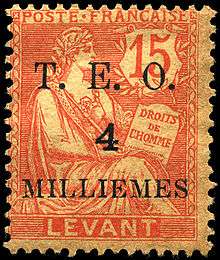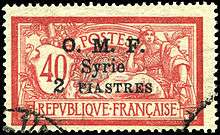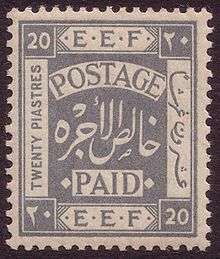Postage stamps and postal history of Syria




This is a survey of the postage stamps and postal history of Syria.
Syria, is a country in Western Asia, bordering Lebanon and the Mediterranean Sea to the west, Turkey to the north, Iraq to the east, Jordan to the south, and Israel to the southwest. The French were awarded a mandate to govern Syria at the Paris Peace conference of 1918 and Syria attained independence in April 1946, as a parliamentary republic.
Early postal arrangements
Syria was part of the Ottoman Empire until the defeat of the Turks in the First World War and an extensive network of Turkish post offices operated in the region. A French post office operated between 1852 and 1914, and an Egyptian office at Latakia from 1870 to 1872.[1] Syria used the stamps of Turkey from 1883 until 1919.[2]
Syrian Arab Kingdom
In 1920 Emir Faisal of the Hejaz organised an Arab Kingdom in central Syria in rebellion against French control. On 8 March 1920 Faisal was proclaimed King of Syria.[1] During this period stamps of Turkey from 1913-1919 were overprinted in Damascus with the Arabic seal Al Hukuma Al Arabia 'Arab Government' and some of the stamps surcharged in Egyptian currency. After Faisal was proclaimed King, a set of stamps was issued by the Arabian Government of Syria, and one of the set, the 5 milliemes, pink, overprinted in Arabic with green ink, "In commemoration of the independence of Syria. Adar (March) 8th 1920." The overprinted Turkish provisionals continued in use for about two months and were used conjunctively with stamps of the E.E.F. and regular Syrian issues.[3]
Egyptian Expeditionary Force
Stamps of the British Egyptian Expeditionary Force were available in Syria between 23 September 1918 and 23 February 1922.[4]
French military occupation
In July 1920 King Faisal was dethroned by the French and a mandate was granted to France by the League of Nations over the whole of Syria from 1923. Following the awarding of the mandate and the defeat of Syrian forces in May 1920, Syria came under French military occupation. Syria got divided between a coastal area with a capital at Beirut, which subsequently became Lebanon, and the interior under the control of the Arabs with a capital at Damascus. Stamps of France were used between 1920 and 1922 overprinted T.E.O. (Territoires Ennemis Occupés) or O.M.F. (Occupation Militaire Francaise).[1] Syria used the stamps of France, overprinted Syrie Grand Liban or Syrie between 1923 and 1924. From 1925 Syria had its own stamps marked Syrie.[1]
Syrian Republic
From 1934 stamps marked Republique Syrienne were in use, changing later to just Syrie. These continued until the end of 1957.[1]
United Arab Republic
On 1 February 1958 Syria and Egypt united to form the United Arab Republic and stamps marked UAR were used.[1]
Syrian Arab Republic
On 28 September 1961 Syria left the UAR and became the Syrian Arab Republic and stamps have been marked first under that name, then Syrian A.R. or just Syria since then.[1]
See also
Further reading
- Philatelic History of the Arab Kingdom of Syria by Alexander Kaczmarczyk and Rodney Unwin Edited by Abed H Najjar, published by London Stamp Exchange. 2014
References
- 1 2 3 4 5 6 7 Stanley Gibbons Stamp Catalogue: Part 19 Middle East. 6th edition. London: Stanley Gibbons, 2005, pp.299-341. ISBN 0-85259-576-X
- ↑ Rossiter, Stuart & John Flower. The Stamp Atlas. London: Macdonald, 1986, pp.218-219. ISBN 0-356-10862-7
- ↑ "The Stamps of Syria" in Stanley Gibbons Monthly Journal, September 1927. Retrieved 10 April 2010.
- ↑ Stanley Gibbons Stamp Catalogue: Part 19 Middle East. p.245.
External links
| Wikimedia Commons has media related to Stamps of Syria. |